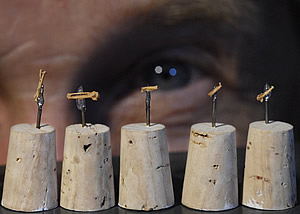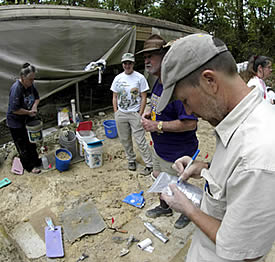Birders in Florida may get a thrill when they spy a ruby-throated hummingbird flitting through their backyard — after all, it is the only species of hummer found in the state — but they may not know that millions of years ago when the climate was warmer and wetter, early hummingbird prototypes may have flown across north central Florida. David Steadman, a paleo-ornithologist at the Florida Museum of Natural History, has an ambitious goal to find the oldest hummingbird fossils in North America, and says the perfect spot to search may be within an hour’s drive from Gainesville.

Photo by Mary E. Warrick
Steadman oversees Thomas Farm, a fossil dig site 45 miles northwest of town. Excavated for decades by Florida Museum scientists and scores of volunteers, early Miocene fossils about 18 million years old are being dug from an ancient sinkhole.
“Thomas Farm seems to be perfectly situated in time as a site to look for fossil hummingbirds,” Steadman said. “We find fossils of other tropical birds there, such as chachalacas, sungrebes, rollers, todies, motmots, puffbirds and barbets. We’ve also found sac-winged, ghostfaced and funnel-eared bats, geckos, and five species of boas which lend support to the idea of a tropical environment in ancient northern Florida.”
And it’s a warm, tropical environment that just may have supported ancient hummingbirds. Today, all 350 modern species of hummingbirds are found only in the Americas. But bird enthusiasts and scientists alike were amazed when a 30- to 34-million-year-old fossil hummingbird was discovered in Germany several years ago and reported by Steadman’s colleague, Gerald Mayr, of the Senckenberg Museum in Frankfurt.
“It was a shock out of the blue that this earliest hummingbird was from Europe,” Steadman said. “There had been virtually no fossil record for hummingbirds beyond 15,000 years ago, and the fossil from Europe was at least 30 million years old. While a primitive species, it was definitely a hummingbird.”
This ancient bird, named Eurotrochilus inexpectatus, which means “unexpected European hummingbird,” was not as efficient as modern hummers at flying or feeding because it had relatively larger legs but a shorter bill and wings. At some point, hummingbirds must have gone extinct in Europe, Steadman said, even though Europe and adjacent Asia and Africa likely had plenty of flowers to nourish the long-beaked, nectar-feeding birds. But scientists are unsure when hummingbirds first colonized the Americas, a vast region where they now flourish.
“From an evolutionary standpoint, hummingbirds must have been in the New World for quite a while in order for them to diversify into so many species,” Steadman said. “If we find a fossil hummingbird at Thomas Farm, the questions become: To what extent did it have the unique physique of modern hummers? And, how closely related is it to any of the modern species?
 “My hypothesis is that any hummingbird fossil we might find at Thomas Farm will represent a species well on its way to becoming modern in its wing anatomy,” Steadman said. “It would probably be able to hover around flowers with the best of them.”
“My hypothesis is that any hummingbird fossil we might find at Thomas Farm will represent a species well on its way to becoming modern in its wing anatomy,” Steadman said. “It would probably be able to hover around flowers with the best of them.”
Today’s hummingbirds have very distinctive wings that allow them to hover, turn quickly, and fly straight up, down or backward. The humerus, or upper arm bone, is shorter and more stout, and its efficient attachment to the breast muscles creates better wing leverage. A normal bird wing’s bones are smaller closer to the tip, just like the bones of a human arm. But a hummingbird’s wing anatomy is reversed. Its three major wing bones, the humerus, ulna and carpometacarpus, are unique because they elongate successively from the shoulder to the wing tip. The carpometacarpus of Eurotrochilus was shorter than in modern hummingbirds, suggesting it probably was not as good at hovering as its modern relatives.
Steadman believes the major north-south migrations of many North American birds, including our local ruby-throated hummingbird, stem from a changing climate.
“Global cooling is an obvious stimulus for migration when you have species that eat fruits, nuts, leafy things and insects,” Steadman said. “My best guess is that the mid-Miocene cooling period, which started roughly 12 to 15 million years ago, probably was the impetus for much of the north-south migration that we see today.”
Until recently, the Florida Museum’s emphasis at Thomas Farm was to find large fossils such as horses, camels and rhinoceroses, but Steadman is shifting the focus to smaller species. He is requiring that all excavated sediment be screened through one-sixteenth-inch mesh to capture the minuscule bones of frogs, toads, lizards, rodents, songbirds, and hopefully, hummingbirds. Some screening is done on site and some back in the Museum.
“Hummingbird bones are tiny but plenty sturdy enough to preserve as fossils,” Steadman said while discussing the probability of finding a hummingbird at Thomas Farm. “Most of the bird fossils from Thomas Farm are from species nearly as small as hummingbirds, so the potential to get that first fossil hummer is great. We just have to keep digging and screening.”
Steadman said the shift in focus to microfossils gives volunteers a new goal, and more workers are needed, especially ones who like to dig and have keen eyes for detail.
“Since the site was first discovered in 1931, Thomas Farm been producing an amazing range of species,” Steadman said. “But we’re nowhere near hitting the point of diminishing returns.”
Learn more about the ornithology at the Florida Museum.